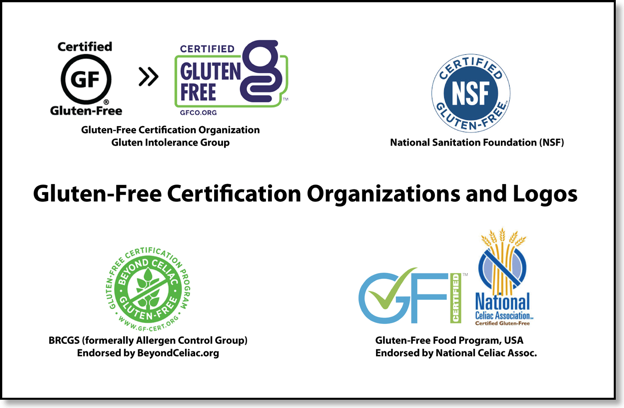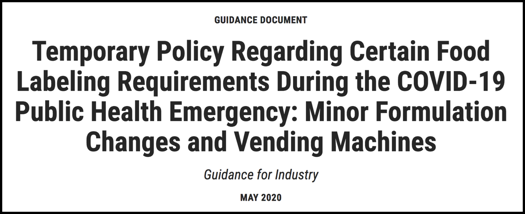FDA Temporary Labeling Requirements During COVID-19
On the evening of Friday, May 22nd 2020, the FDA issued new guidance relaxing the requirements around the labeling of ingredients due to the supply issues caused by the COVID-19 pandemic. As one might expect, this rocked the world of those with food allergies as well as those with gluten-related disorders. “FDA is issuing this guidance to food manufacturers to provide temporary and limited flexibilities in food labeling requirements under certain circumstances. Our goal is to provide regulatory flexibility, where fitting, to help minimize the impact of supply chain disruptions associated with the current COVID-19 pandemic on product availability. For example, we are providing flexibility for manufacturers to use existing labels, without making otherwise required changes, when making minor formula adjustments due to unforeseen shortages or supply chain disruptions brought about by the COVID-19 pandemic.” In response to the COVID-19 pandemic, the FDA is allowing manufacturers to make minor changes in packaged food ingredients without updating ingredient lists to reflect these changes. The guidance states that this should only be done when the ingredient being substituted does “not cause any adverse health effect”, with “gluten” being specifically noted as an example of an ingredient that should not be substituted in. In other words, this FDA guidance theoretically means that a product which was previously gluten-free would remain gluten-free, even if some ingredient(s) are modified. But the possibility does exist that companies could inadvertently substitute in a gluten-containing ingredient that would not be noted in the ingredient list. “Ms. Vargas served on the expert panel to develop Voluntary Recommendations for Managing Celiac Disease in Schools, Child Care and Education Programs, a joint effort of Children’s National Medical Center, the Celiac Disease Foundation, and RESOLVE.” If you haven’t yet read this guidance, it states in a nutshell that during this period of food shortages and supply disruptions, FDA is allowing manufacturers to make certain ingredient substitutions without changing the ingredients list.Allowed substitutions include those for minor ingredients (generally comprising 2% or less by weight of the product). FDA states that these changes should* be consistent with safety factors meaning that “the ingredient being substituted for the labeled ingredient does not cause any adverse health effect (including food allergens, gluten, sulfites, or other ingredients known to cause sensitivities in some people, for example, glutamates).” Allowed substitutions also include “different varieties of the same ingredient.”* The use of “should” in an FDA guidance document means that something is suggested or recommended, but not required.
Here are a few resources to help us learn more about this change.
Read More: https://bit.ly/3fziFy2
Download Guidance PDF: https://bit.ly/2Nemkoz
Laura Allred, Ph.D. - GFCO Regulatory Manager and Lola O’Rourke, MS, RDN - GIG Education Coordinator discuss the impact of this ruling.
Watch the Webinar: https://bit.ly/2YJeDfo
Notes:
Mary Vargas, partner, discusses some of the legal details of the FDA’s guidance.
Watch the Video: https://bit.ly/3d5bQT1
Notes:
Gluten-Free Watchdog gives us their analysis of this policy and some suggestions for managing it.
Gluten-Free Watchdog's Entire Article: https://bit.ly/2UOdQsm
Notes:
Urgent Call to Action: Comment today on FDA's temporary policy allowing manufacturers to make certain ingredient substitutions without changing the ingredients list - June 2020
It's essential to have our voices heard about this policy. Future labeling practices maybe be defined by this [as of now] temporary policy. You can add your comment to Docket number FDA-2020-D-1139-0009.
Gluten-Free Watchdog suggests we can use any or all of the submitted letter. Or you can state that you are in support of the letter sent by Gluten-Free Watchdog. Here is a PDF of the letter submitted to the FDA: https://bit.ly/2Ndn2m7
Click here to let the FDA know how you feel: https://bit.ly/2NeXzsE
Gluten-Free Watchdog's Entire Article: https://bit.ly/2YzfgIw
SnackSafely.com is assembling a list of companies that have pledged to label all ingredients despite the changes. Excellent!
Special thanks to my friend Sarah @ Celiac in the City for sharing this list!
List of Manufacturers: https://bit.ly/2N69bha

To be compliant, manufacturers must follow a few general guidelines when determining whether an undeclared ingredient substitution is allowed: The change can’t compromise the safety of the product (eg, introduction of major allergens or other sensitive ingredients). The omitted ingredient can’t be a major ingredient (eg, replacing wheat flour with rice flour in a muffin) or a characterizing ingredient (eg, replacing butter with margarine in a product with a “made with real butter” claim). The change can’t impact nutrient content or health claims made on the label. The change can’t have a significant impact on the nutritional quality of the finished product. Substitutions of Different Varieties of the Same IngredientDifferent varieties of the same ingredient, such as fruits or vegetables, may be freely substituted without label changes. For example, a product listing “jalapeño peppers” in the ingredients list may substitute another variety of pepper, regardless of whether it’s a major or minor ingredient.Manufacturers also may temporarily substitute fats and oils without label changes if they’re from the same category of fat (animal/vegetable/marine animal) and have a similar fatty acid profile.Similarly, due to a low supply of bleaching agent, products declaring “bleached flour” as an ingredient may substitute unbleached flour without declaring it in ingredients lists.
Read entire article: https://bit.ly/386Hteg
Updates:
06/26/20 - Added Today’s Dietitian link.
